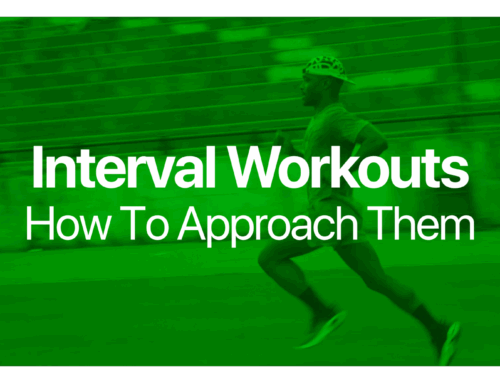By Dr. Jack Daniels
There are really only two types of training a person can do: steady running and intermittent running. By steady running I mean a non-stop run at a consistent intensity. The intensity may be very easy, as at the beginning of a warm-up, during cool-downs or during recovery runs; or it may be moderate, as when running at Marathon pace or Threshold pace. Any intensity faster than threshold pace will usually be associated with intermittent running, as during Interval or Repetition workouts, types of training that stress the aerobic system or that work on mechanics, speed and economy.
Intermittent training simply means the workout alternates between bouts of work and recovery, and the recoveries may or may not be active in nature. Usually with longer work bouts you also take longer periods of recovery, but on a treadmill this is very simple to control for. A single session can also involve a mixture of different intensities and durations of running, along with varying bouts of recovery, something that is typically referred to as “fartlek” training.
Hill Training Advantages
A big advantage treadmill running has on over-ground running is in the area of hill training. Over-ground hill work invariably involves both up and down-hill running, which can be good if that is what you want. However, often a runner wants the up-hill aspect of the workout without the negative aspects of running back down, and that is easy to do on a treadmill. You run up for a period of time then just hop off the TM for recovery before starting the next up-hill run. This is particularly desirable for a runner who may be nursing a minor injury that is aggravated by running downhill, but the injury is not aggravated during up-hill running as the impact is reduced going uphill. It is very possible to get in some real demanding workouts at a very slow pace provided the grade is steep enough.
For those who want to prepare for a race that involves a good deal of downhill running, as is experienced in the Boston marathon for example, then some downhill training can be a good idea. It is possible to get a treadmill that can be adjusted to some degrees of downhill configuration, but that costs a fair amount more. Another option is to jack up the rear end of a normal treadmill with a railroad tie or some similar chunk of strong wood. For example, if you have a treadmill that goes up to 20% grade and when a carpenter’s level tells you the running belt is level when the dial reads 5%, then you know you can go down to negative 5% if you set the dial at 0%. You will then have a TM that can go from -5% to +15% grade. Of course it is important to make sure your treadmill is firmly attached to the supporting block, so some vibration or an unsuspecting person might knock it off its block.
Downhill Training
A word of caution about running downhill, be it over ground or on a treadmill. Just as running uphill reduces impact of landing, running downhill increases impact. It is wise to add bouts of downhill running rather gradually to a training program so you don’t bring on an injury associated with the extra landing shock. It is probably best to stay away from downhill training during the final weeks before an important race, and certainly don’t start some downhill training unless you have at least six or eight weeks of time prior to an important race. Always experiment with a new type of training during the off season or early in your training cycle. The majority of TM training is either on a level or positive grade for most people, and negative-grade running need not be of concern for the average, or even some elite, runners.
Speed/Grade Intensity Tables
In an effort to minimize boredom and to provide more variety to TM training, I have generated some tables (See Daniels’ Running Formula) that combine speed and grade to equal a variety of flat-ground speed demands. One advantage of using the intensity tables is that it allows runners to achieve the desired intensity of training without running necessarily fast all the time. Some treadmills will not go as fast as may be desired to achieve true interval pace so by adding some grade to a slower speed the targeted system of the body is still stressed to its limit.
Be aware of the fact that any speed of running (10 MPH for example) on a treadmill, is slightly less demanding than is that same speed during over-ground running on a track or flat road. This is because when you run over ground you are creating a headwind, even on a calm day. If you run at 10MPH, for example, and no wind is blowing, you are creating a 10MPH head wind and that makes the energy demand a little greater than running with no wind resistance on a treadmill.
Disadvantage Of Treadmill Running
The lack of air resistance on a treadmill brings up another problem, and that is cooling. As time goes by on a treadmill you will build up a layer of warm and humid air around your body, and a fan can be most pleasing in helping to keep you from over-heating by blowing that warm humid air away from your body. Of course, if you are training for a race in warm, humid conditions, then eliminate the fan so you can acclimate to the heat.
Although it is not necessarily a constant, adding a 2% grade to your treadmill will increase the demand of running on the TM to just about what it would be outside on a calm day, at the same running speed. This slight grade makes up for not having any air resistance to deal with. Interestingly, if you are checking heart rate now and then you may find a little higher value on the treadmill because of the warmer conditions your body faces tend to result in an increase in heart rate. The intensity tables I have calculated usually take into account the lack of air resistance while on the treadmill.
Also view Treadmill Running, Part III – Calibrating Your Treadmill. Customize a training plan for your next race from legendary coach Daniels here.




